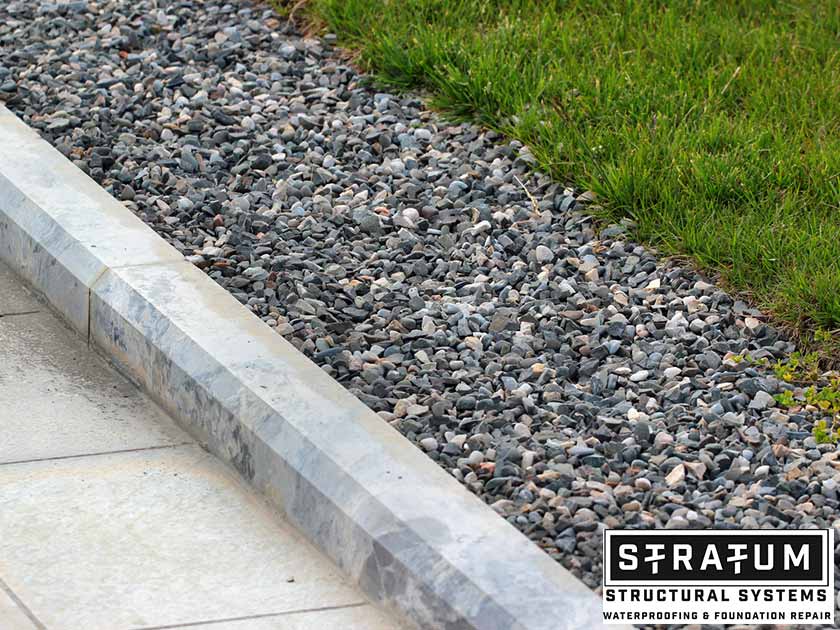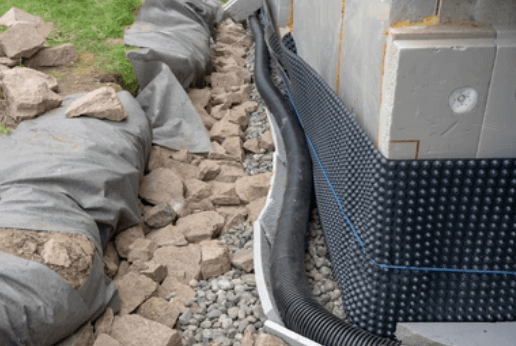Weighing DIY vs. Professional Portland French Drain Setup
Weighing DIY vs. Professional Portland French Drain Setup
Blog Article
How a French Drainpipe Can Help Prevent Water Damage in Your Cellar
A French drain could be the option you require if you're dealing with a wet basement. This system effectively redirects water away from your structure, helping to protect against pricey damage. Understanding exactly how it works and identifying the signs that you require one can make a significant distinction in your home's security and comfort. However before you determine, it's important to check out the advantages and installment process to see if it's the best suitable for your circumstance
What Is a French Drainpipe?
A French drainpipe is a simple yet effective option for taking care of excess water around your residential or commercial property. It's created to redirect water far from vulnerable areas, like your basement or structure. Typically, it consists of a trench full of gravel and a perforated pipeline that collects and channels water. When rain or groundwater develops, the drain efficiently guides it away, stopping prospective damage.You could notice French drains pipes set up along residential or commercial property lines, driveways, and even near your home's foundation. They can be found in different sizes and setups, making them versatile to different landscapes and drainage demands. Installing a French drainpipe can aid you prevent expensive repair services and safeguard your home's architectural honesty. A French drainpipe might be the remedy you need if you've been dealing with water merging or soggy areas in your yard. It's a proactive measure to ensure your home remains risk-free and completely dry from water-related problems.
Just how Does a French Drain Job?
When water collects around your property, a French drain kicks right into activity to redirect it properly. This system includes a trench loaded with crushed rock and a perforated pipe at the bottom. The pipe accumulates excess water from the soil and channels it away from your foundation.As rain or groundwater seeps right into the crushed rock, it streams with the perforations and into the pipeline. Gravity does the work, pulling the water far from your basement and routing it to a designated drainage location, like a storm drainpipe or completely dry well.You can install a French drain either inside or outside your home. If you pick an outside arrangement, it'll prevent water from merging near your structure. An indoor drain will certainly record water that leaks via your cellar wall surfaces. This efficient style keeps your room completely dry, enabling you to appreciate your home without the fear of water damage.
Advantages of Mounting a French Drainpipe
Setting up a French drainpipe can considerably improve your home's strength against water damage. You'll enjoy efficient water diversion, which helps in reducing mold and mildew development and protect your property. Plus, a well-kept drainage system can also improve your building's worth.
Efficient Water Diversion

Decreased Mold And Mildew Growth
Since dampness creates a best atmosphere for mold and mildew to thrive, minimizing water buildup around your home is vital for maintaining a healthy space. Installing a French drainpipe successfully networks excess water far from your foundation, keeping your cellar completely dry. This aggressive action greatly lowers moisture levels, making it harder for mold and mildew spores to clear up and grow.With much less moisture, you'll locate it less complicated to take a breath and take pleasure in a clean, secure environment. And also, you'll lower the danger of health issues connected with mold exposure, such as allergies and respiratory system issues. By investing in a French drainpipe, you're taking a vital action toward a mold-free cellar, ensuring that your home remains a comfy area for you and your family.
Increased Building Worth
A French drain can substantially boost your home's value, making it a smart investment for homeowners. When possible purchasers see a well-maintained basement without water damage, they're most likely to be pleased. This attribute not just improves your home's appeal but additionally indicates that you've taken proactive steps to safeguard it. By lowering the threat of water-related concerns, your building becomes a lot more attractive in an open market, often leading to greater offers. In addition, the lasting financial savings on repair work and upkeep can translate into increased equity. Installing a French drain reveals you respect your home's stability, assuring purchasers that they're making a sound purchase. Inevitably, it's a beneficial addition that pays off in more ways than one.
Signs You Need a French Drain
If you notice consistent water build-up in your yard or basement, it's a clear sign that you could need a French drainpipe. Additionally, a mildewy odor can indicate trapped moisture, which can result in larger troubles. Attending to these indicators early can assist stop major water damages to your home.
Persistent Water Accumulation
When you notice consistent water build-up around your home, it's a clear sign that a French drain might be required. Water merging near your structure can bring about substantial damages in time, consisting of structural concerns and mold and mildew growth. You should pay focus to locations where water appears to collect after hefty rains or snowmelt. If your backyard stays soggy for days, it's time to take activity. In addition, look for signs of disintegration or sloppy spots, as these can show poor water drainage. Installing a French drain aids reroute water away from your home, shielding your foundation and minimizing the danger of water damages. Don't await bigger issues to develop-- resolving water accumulation currently can save you pricey repair services later on.
Mildewy Odor Existence
Relentless water accumulation typically leads to greater than just noticeable pooling; it can produce a setting ripe for musty smells. If you notice a damp, stagnant odor in your basement, it's an indication that moisture is sticking around, frequently due to bad drain. This smell usually indicates mold or mildew development, which can position wellness threats and harm your items. You may discover that the odor aggravates throughout humid weather or after hefty rainfalls. If you're fighting persistent moldy smells, it's time to review a French drain. This system redirects water far from your structure, lowering dampness degrees and combating those unpleasant smells. Don't overlook this caution sign; addressing it immediately can conserve you from a lot more comprehensive water damages down the line.
The Installation Process of a French Drainpipe
Setting up a click this link French drainpipe can be a straightforward process that greatly enhances your home's water damages avoidance. Initially, assess the location where you want to set up the drain, ensuring it slopes far from your structure. Next, note the trench's course, which should have to do with 6-8 inches vast and 18-24 inches deep.Excavate the trench, eliminating soil as required. Portland French Drain. Lay down landscape textile to protect against dirt from clogging the drainpipe as soon as you've check got your trench. After that, include a layer of gravel near the bottom. Place a perforated pipe on top of the crushed rock, making sure the openings face downward for efficient drainage.Cover the pipeline with even more gravel, leaving about 3 inches of area at the top. Fold the landscape fabric over the gravel to shield it. Fill in the trench with soil, compacting it as you go. You've now established a trustworthy system to reroute water away from your cellar!
Upkeep Tips for Your French Drain
Although a French drainpipe is created to effectively manage water flow, regular maintenance is important to validate its ongoing performance. Begin by inspecting the drainpipe and its surroundings for debris or clogs. Clear any leaves, dirt, or sediment that might build up, especially after hefty rains.Next, check the outlet for correct drain. It needs to direct water away from your foundation-- if it doesn't, you might require to change its position. Additionally, verify that the gravel surrounding the drain is undamaged and hasn't settled in time; this helps maintain proper water flow.Consider arranging an annual professional inspection to catch any type of concerns early. If you notice any type of indicators of water damage or pooling, resolve them right away to prevent bigger problems in the future. With a little attention, your French drain can efficiently safeguard your basement for years to come.
Cost Factors To Consider and Long-Term Financial Savings
When considering a French drainpipe, it's vital to consider both the preliminary investment and the long-lasting savings it can supply. While the ahead of time price may seem significant, consider it as an investment in your house's future. Mounting a French drain commonly ranges from $1,500 to $5,500, depending upon your basement's dimension and the complexity of the installation.However, this price can conserve you thousands in prospective water damage, mold and mildew removal, and structure repairs. By stopping water accumulation, you're likewise shielding your home's value and avoiding pricey insurance claims. Additionally, a dry basement can reduce your power expenses, as dampness can lead to enhanced cooling and heating prices. Ultimately, the comfort that features understanding your home is protected from water damages is valuable. Take into consideration these aspects meticulously to make a knowledgeable decision that benefits you over time.

Often Asked Concerns
Can a French Drain Be Mounted in Any Type Of Sort Of Soil?
Yes, a French drainpipe can be set up in various soil kinds, including sand, clay, and loam. However, correct installation and drainage preparation are necessary to guarantee it functions successfully in your details dirt problems.
For how long Does a French Drain Last Before Needing Replacement?
A French drainpipe generally lasts around 30 to 40 years with appropriate setup and maintenance. Factors like soil type and water circulation can influence its lifespan, so keep an eye on its efficiency.
Can French Drains Pipes Assist With Backyard Drain Issues?
Yes, French drains pipes can efficiently resolve yard water drainage problems. They route excess water far from trouble areas, stopping merging and guaranteeing your landscape stays healthy and balanced. Installing one can substantially boost your backyard's overall water drainage performance.
Will a French Drainpipe Affect My Landscaping or Yard?
A French drain can affect your landscape design or garden, specifically if it's mounted incorrectly. You'll wish to make specific it's placed strategically to minimize disturbance, preserving your plants and general aesthetic while enhancing water drainage.
Are There Alternatives to French Drainpipes for Cellar Water Issues?
Yes, there are choices to French drains pipes for cellar water issues. You could take into consideration sump pumps, waterproof coverings, or rating your yard to reroute water away. Each choice has its benefits, so assess what matches your needs best. When rain or groundwater builds up, the drainpipe successfully guides it away, avoiding potential damage.You could see French drains mounted along building lines, driveways, or even near your home's structure. Gravity does the job, pulling the water away from your cellar and routing it to a designated drainage area, like a tornado drain or dry well.You can install a French drainpipe either inside or outside your home. By effectively funneling water away from your building, a French drain can considerably lower the risk of water damages. Mounting a French drainpipe aids reroute water away from your home, securing read here your structure and lowering the danger of water damages. Setting up a French drainpipe can be an uncomplicated process that substantially improves your home's water damages avoidance.
Report this page